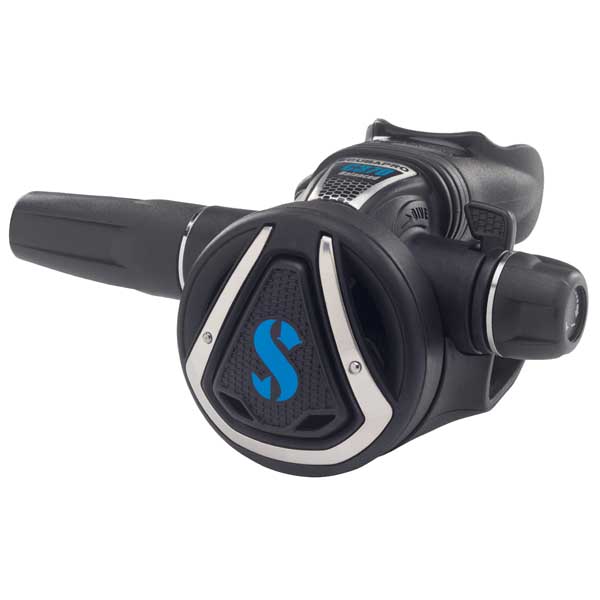
Scubapro’s MK11 first stage has been around for a while now, but the latest version, coupled with the C370 second stage released in December 2017 provides an excellent entry-level option for the travelling diver. The classic Mk2/R195 combo, much loved by dive centres around the world is still available for the lowest of price points, but the Mk11/C370’s versatility and performance far exceeds that of the Mk2/R195, with an RRP of only £24 more.
Mk11 first stage
At just over 60mm in height, the Mk11 is one of the most compact regulators around, with the DIN version weighing in at just 490g (710g for the INT version). Despite the low profile, it still manages to fit two HP and 4 LP ports onto the fixed barrel.
The Mk11 is of an air-balanced diaphragm design and bears the EN250 stamp for cold-water use, however, the chamber is not dry-sealed and it doesn’t have the anti-freeze coating present in the Mk25 or Mk17 regulators. Dedicated cold-water divers will probably be looking at a higher-spec regulator in the first place, but the Mk11 does cover most of the temperatures that a recreational diver is likely to encounter.
Port placement has the HP port situated in-between and forward of the LP ports. This is not unique in the world of regulators, but I’m uncertain if the claim of port positioning ‘for optimal hose routing’ is applicable. Depending on how you orient the regulator and to which LP ports you connect the second stage and LPI hoses, the ‘standard’ recreational setup means that the inflator hose is either above or below – but always behind the HP hose. A fellow diver remarked that they thought it looked to be set up ‘backwards’, and while I agree – I much prefer my HP port to be well below the LP port for ease of routing – the port location is really not a problem.
Two of the four LP ports are labelled ‘HFP’, or ‘High Flow’ ports – delivering 15 per cent greater airflow than the other two, regular ports. These are intended for use with the second stages, and although it was not particularly noticeable on the C370, there was a definite improvement with my older, unbalanced octopus.
Overall, the compact, lightweight Mk11 is an excellent first stage, easily allowing for a standard setup, plus wireless transmitter and drysuit inflator if needed.
C370 Second Stage

Also compact and, at only 190g, the balanced C370 primary second stage is very lightweight, yet without sacrificing anything in terms of build quality. It is a very solid design, feels extremely robust, and has a little more versatility than some other available second stages.
The purge button is large and rubbery and thick gloves would be no impediment to its use. The Venturi lever operates with only a tiny amount of adjustment and the airflow control knob operates through almost three complete turns, giving plenty of adjustment to the air flow control. The exhaust tee is one of the most firmly attached I have seen to date, although I felt that if it were a little bit wider, there would have been fewer bubbles in my face.
When airflow adjustment is available on a second stage, I like mine wound down to the bare minimum. I have no particular reason for this other than I like it that way, perhaps a hangover from many years ago when I was working to bring my air consumption under control and timing my breathing patterns, and I preferred feeling as if I was pulling the air out of the regulator, rather than having it pushed into my mouth.
Before anybody comments on the daftness of that idea, I will also point out that it’s purely psychological, has no basis in mechanics or fluid dynamics – but it sort of worked for me, and that’s why I like it.
Verdict
Overall, I like this regulator combo a lot. I don’t love it as much as my personal, ‘Legendary’ regs but there’s not a lot in it. I would prefer it if the Mk11 first stage had its ports arranged slightly differently on the barrel, but the C370 is an impeccable second stage and there is absolutely nothing to fault it.
One significant advantage that the Mk11/C370 has though, is the price tag. At £229 it is one of – if not the – least expensive balanced diaphragm regulators on the market. Technical and dedicated cold-water divers will be looking higher up the list of specifications but as an all-around, lightweight, recreational travel regulator, the Mk11/C370 is an excellent choice.
Mk11 Features & specs
- Fittings: Yoke or DIN
- Balanced diaphragm
- Marine grade brass barrel
- Environmentally sealed
- External intermediate pressure adjustment
- Cold Water: Yes
- Ports: 2 HP, 2 LP, 2 HFP (High Flow)
- Weight: 490g (DIN), 710g (yoke)
C370 Features & specs
- Air balanced valve for smooth inhalation effort at varying depths and supply pressures.
- Compact rugged fibreglass reinforced nylon casing and new exhaust tee.
- A new poppet and lever allow the design to maintain the same overall size as the C350.
- Stainless steel frame on the front cover with the Scubapro C-Series signature.
- User controls include a diver-adjustable inhalation effort knob and coaxial Venturi-Initiated Vacuum Assist (VIVA).
- Large purge button, excellent for thick gloves.
- Super-flow hose features an oversized bore that allows more air to flow on each inhalation.
- Compact Hi-Flow mouthpiece improves airflow as well as mouth comfort, fitting all mouth sizes, from smaller to largest.
- Weight: 171g
Scubapro MK11 / C370 RRP: £229


